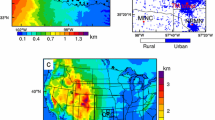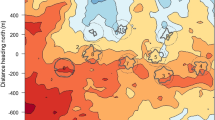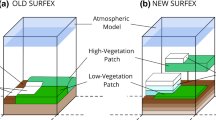Abstract
The stably stratified atmospheric boundary layer (SBL) has been found in previous studies to display distinct regimes of behaviour. In particular, a contrast is often drawn between the weakly (wSBL) and very (vSBL) stable boundary layers. Time series of SBL regime affiliation obtained from hidden Markov model analyses of data from three different towers at the Los Alamos National Laboratory are used to investigate the spatial dependence of SBL regime occupation and SBL transitions. The local topography influences the flow such that south-west to north-east flow prevails, for which wSBL and vSBL conditions respectively are more likely to occur. Joint probabilities of shared regime occupation at the three towers (with and without conditioning on wind direction) are much larger than would be expected from statistically independent regime sequences at the different locations. Very persistent wSBL nights (without any transitions to the vSBL) have a higher probability of occurring across the entire tower network domain than very persistent vSBL nights. Many regime transitions occur within a narrow time window between the different towers; occurrence probabilities of such events are much higher than would be expected from statistically independent regime transitions. Of such events, transitions occurring at exactly the same time across the tower network occur most often. Many co-occurring turbulence recovery events can be associated with high-intensity intermittent turbulence events. Our results imply that the scale on which the SBL regime occupation and transitions are dependent exceeds 10 km in this region of complex terrain.











Similar content being viewed by others
Change history
08 February 2021
A Correction to this paper has been published: https://doi.org/10.1007/s10546-020-00600-2
References
Abraham C, Monahan AH (2019a) Climatological features of the weakly and very stably stratified nocturnal boundary layers Part I: state variables containing information about regime occupation. J Atoms Sci 76:3455–3484. https://doi.org/10.1175/JAS-D-18-0261.1
Abraham C, Monahan AH (2019b) Climatological features of the weakly and very stably stratified nocturnal boundary layers Part II: regime occupation and transition statistics and the influence of external drivers. J Atmos Sci 76:3485–3504. https://doi.org/10.1175/JAS-D-19-0078.1
Abraham C, Monahan AH (2019c) Climatological features of the weakly and very stably stratified nocturnal boundary layers Part III: the structure of meteorological state variables in persistent regime nights and across regime transitions. J Atmos Sci 76:3505–3527. https://doi.org/10.1175/JAS-D-18-0274.1
Abraham C, Holdsworth AM, Monahan AH (2019) A prototype stochastic parameterization of regime behaviour in the stably stratified atmospheric boundary layer. Nonlinear Process Geophys 26:401–427. https://doi.org/10.5194/npg-26-401-2019
Acevedo OC, Fitzjarrald DR (2003) In the core of the night-effects of intermittent mixing on a horizontally heterogeneous surface. Boundary-Layer Meteorol 106(1):1–33. https://doi.org/10.1023/A:1020824109575
Acevedo OC, Moraes OLL, Degrazia GA, Medeiros LE (2006) Intermittency and the exchange of scalars in the nocturnal surface layer. Boundary-Layer Meteorol 119(1):41–55. https://doi.org/10.1007/s10546-005-9019-3
Acevedo OC, Mahrt L, Puhales FS, Costa FD, Medeiros LE, Degrazia GA (2016) Contrasting structures between the decoupled and coupled states of the stable boundary layer. Q J R Meteorol Soc 142(695):693–702. https://doi.org/10.1002/qj.2693
Acevedo OC, Maroneze R, Costa FD, Puhales FS, Nogueira Martins LG, Soares de Oliveira PE, Mortarini L (2019) The nocturnal boundary layer transition from weakly to very stable. Part 1: observations. Q J R Meteorol Soc. https://doi.org/10.1002/qj.3642
Anfossi D, Oettl D, Degrazia G, Goulart A (2005) An analysis of sonic anemometer observations in low wind speed conditions. Boundary-Layer Meteorol 114(1):179–203. https://doi.org/10.1007/s10546-004-1984-4
Ansorge C, Mellado JP (2014) Global intermittency and collapsing turbulence in the stratified planetary boundary layer. Boundary-Layer Meteorol 153(1):89–116. https://doi.org/10.1007/s10546-014-9941-3
Basu S, Porté-agel F, Foufoula-Georgiou E, Vinuesa JF, Pahlow M (2006) Revisiting the local scaling hypothesis in stably stratified atmospheric boundary-layer turbulence: an integration of field and laboratory measurements with large-eddy simulations. Boundary-Layer Meteorol 119(3):473–500. https://doi.org/10.1007/s10546-005-9036-2
Blumen W, Banta R, Burns SP, Fritts DC, Newsom R, Poulos GS, Sun J (2001) Turbulence statistics of a Kelvin-Helmholtz billow event observed in the night-time boundary layer during the cooperative atmosphere-surface exchange study field program. Dyn Atmos Oceans 34(2–4):189–204. https://doi.org/10.1016/S0377-0265(01)00067-7
Bonin TA, Blumberg WG, Klein PM, Chilson PB (2015) Thermodynamic and turbulence characteristics of the southern Great Plains nocturnal boundary layer under differing turbulent regimes. Boundary-Layer Meteorol 157(3):401–420. https://doi.org/10.1007/s10546-015-0072-2
Bruggeman DA (2017) Los Alamos climatology 2016 update. Los Alamos National Laboratory. https://permalink.lanl.gov/object/tr?what=info:lanl-repo/lareport/LA-UR-17-21060, Tech rep. Accessed 12 Nov 2019
Coulter RL, Doran JC (2002) Spatial and temporal occurrences of intermittent turbulence during CASES-99. Boundary-Layer Meteorol 105(2):329–349. https://doi.org/10.1023/A:1019993703820
Donda JMM, van Hooijdonk IGS, Moene AF, Jonker HJJ, van Heijst GJF, Clercx HJH, van de Wiel BJH (2015) Collapse of turbulence in stably stratified channel flow: a transient phenomenon. Q J R Meteorol Soc 141(691):2137–2147. https://doi.org/10.1002/qj.2511
Doran JC (2004) Characteristics of intermittent turbulent temperature fluxes in stable conditions. Boundary-Layer Meteorol 112(2):241–255. https://doi.org/10.1023/B:BOUN.0000027907.06649.d0
Flores O, Riley JJ (2011) Analysis of turbulence collapse in the stably stratified surface layer using direct numerical simulation. Boundary-Layer Meteorol 139(2):241–259. https://doi.org/10.1007/s10546-011-9588-2
Goulart AGO, Degrazia GA, Acevedo OC, Anfossi D (2007) Theoretical considerations of meandering winds in simplified conditions. Boundary-Layer Meteorol 125(2):279–287. https://doi.org/10.1007/s10546-007-9179-4
He Y, McFarlane NA, Monahan AH (2012) The influence of boundary layer processes on the diurnal variation of the climatological near-surface wind speed probability distribution over land. J Clim 115(D04):103. https://doi.org/10.1175/JCLI-D-11-00321.1
Holdsworth AM, Monahan AH (2019) Turbulent collapse and recovery in the stable boundary layer using an idealized model of pressure-driven flow with a surface energy budget. J Atmos Sci 76(5):1307–1327. https://doi.org/10.1175/JAS-D-18-0312.1 (Submitted to)
Holdsworth AM, Rees T, Monahan AH (2016) Parameterization sensitivity and instability characteristics of the maximum sustainable heat flux framework for predicting turbulent collapse. J Atmos Sci 73:3527–3540. https://doi.org/10.1175/JAS-D-16-0057.1
Lang F, Belušić D, Siems S (2018) Observations of wind-direction variability in the nocturnal boundary layer. Boundary-Layer Meteorol 166(1):51–68. https://doi.org/10.1007/s10546-017-0296-4
Mahrt L (1998) Nocturnal boundary-layer regimes. Boundary-Layer Meteorol 88(2):255–278. https://doi.org/10.1023/A:1001171313493
Mahrt L (2010) Common microfronts and other solitary events in the nocturnal boundary layer. Q J R Meteorol Soc 136(652):1712–1722. https://doi.org/10.1002/qj.694
Mahrt L (2011) The near-calm stable boundary layer. Boundary-Layer Meteorol 140(3):343–360. https://doi.org/10.1007/s10546-011-9616-2
Mahrt L (2014) Stably stratified atmospheric boundary layers. Annu Rev Fluid Mech 46:23–45. https://doi.org/10.1146/annurev-fluid-010313-141354
Mahrt L, Thomas C, Richardson S, Seaman N, Stauffer D, Zeeman M (2013) Non-stationary generation of weak turbulence for very stable and weak-wind conditions. Boundary-Layer Meteorol 147(2):179–199. https://doi.org/10.1007/s10546-012-9782-x
Mahrt L, Sun J, Stauffer D (2015) Dependence of turbulent velocities on wind speed and stratification. Boundary-Layer Meteorol 155(1):55–71. https://doi.org/10.1007/s10546-014-9992-5
Mauritsen T, Svensson G (2007) Observations of stably stratified shear-driven atmospheric turbulence at low and high Richardson numbers. J Atmos Sci 64:645–655. https://doi.org/10.1175/JAS3856.1
McCabe A, Brown AR (2007) The role of surface heterogeneity in modelling the stable boundary layer. Boundary-Layer Meteorol 122(3):517–534. https://doi.org/10.1007/s10546-006-9119-8
Medeiros LE, Fitzjarrald DR (2014) Stable boundary layer in complex terrain. Part I: linking fluxes and intermittency to an average stability index. J Appl Meteorol Clim 53:2196–2215. https://doi.org/10.1175/JAMC-D-13-0345.1
Medeiros LE, Fitzjarrald DR (2015) Stable boundary layer in complex terrain. Part II: geometrical and sheltering effects on mixing. J Appl Meteorol Clim 54(1):170–188. https://doi.org/10.1175/JAMC-D-13-0346.1
Monahan AH, Rees T, He Y, McFarlane N (2015) Multiple regimes of wind, stratification, and turbulence in the stable boundary layer. J Atmos Sci 72:3178–3198. https://doi.org/10.1175/JAS-D-14-0311.1
Mortarini L, Maldaner S, Moor LP, Stefanello MB, Acevedo O, Degrazia G, Anfossi D (2016) Temperature auto-correlation and spectra functions in low-wind meandering conditions. Q J R Meteorol Soc 142(698):1881–1889. https://doi.org/10.1002/qj.2796
Mortarini L, Cava D, Giostra U, Costa FD, Degrazia G, Anfossi D, Acevedo O (2019) Horizontal meandering as a distinctive feature of the stable boundary layer. J Atmos Sci 76(10):3029–3046. https://doi.org/10.1175/JAS-D-18-0280.1
Nappo CJ (1991) Sporadic breakdowns of stability in the PBL over simple and complex terrain. Boundary-Layer Meteorol 54(1):69–87. https://doi.org/10.1007/BF00119413
Nappo C, Sun J, Mahrt L, Belušić D (2014) Determining wave-turbulence interactions in the stable boundary layer. Bull Am Meteorol Soc 95:ES11–ES13. https://doi.org/10.1175/BAMS-D-12-00235.1
Newsom RK, Banta RM (2003) Shear-flow instability in the stable nocturnal boundary layer as observed by Doppler Lidar during CASES-99. J Atmos Sci 60:16–33. https://doi.org/10.1175/1520-0469(2003)060<0016:SFIITS>2.0.CO;2
O’Brien TA, DCollins W, ARauscher S, Ringler TD (2014) Reducing the computational cost of the ECF using a nuFFT: a fast and objective probability density estimation method. Comput Stat Data Anal 79:222–234. https://doi.org/10.1016/j.csda.2014.06.002
O’Brien TA, Kashinath K, Cavanaugh NR, DCollins W, O’Brien JP (2016) A fast and objective multidimensional kernel density estimation method: fastKDE. Comput Stat Data Anal 101:148–160. https://doi.org/10.1016/j.csda.2016.02.014
Rabiner LR (1989) A tutorial on hidden Markov models and selected applications in speech recognition. Proc IEEEE 77:257–286. https://doi.org/10.1109/5.18626
Rees JM, Mobbs SD (1988) Studies of internal gravity waves at Halley Base, Antarctica, using wind observations. Q J R Meteorol Soc 114(482):939–966. https://doi.org/10.1002/qj.49711448206
Rishel J, Johnson S, Holt D (2003) Meteorological monitoring at Los Alamos. Los Alamos National Progress Report LA-UR-03-9097. Los Alamos National Laboratory. https://envweb.lanl.gov/weathermachine/downloads/LA-UR-03-8097_webcopy.pdf, Tech rep. Accessed 12 Nov 2019
Sun J, Burns SP, Lenschow DH, Banta R, Newsom R, Coulter R, Frasier S, Ince T, Nappo C, Cuxart J, Blumen W, Lee X, Hu XZ (2002) Intermittent turbulence associated with a density current passage in the stable boundary layer. Boundary-Layer Meteorol 105(2):199–219. https://doi.org/10.1023/A:1019969131774
Sun J, Lenschow DH, Burns SP, Banta RM, Newsom RK, Coulter R, Frasier S, Ince T, Nappo C, Balsley BB, Jensen M, Mahrt L, Miller D, Skelly B (2004) Atmospheric disturbances that generate intermittent turbulence in nocturnal boundary layers. Boundary-Layer Meteorol 110(2):255–279. https://doi.org/10.1023/A:1026097926169
Sun J, Mahrt L, Banta RM, Pichugina YL (2012) Turbulence regimes and turbulence intermittency in the stable boundary layer during CASES-99. J Atmos Sci 69:338–351. https://doi.org/10.1175/JAS-D-11-082.1
Sun J, Mahrt L, Nappo C, Lenschow DH (2015a) Wind and temperature oscillations generated by wave-turbulence interactions in the stably stratified boundary layer. J Atmos Sci 72:1484–1503. https://doi.org/10.1175/JAS-D-14-0129.1
Sun J, Nappo CJ, Mahrt L, Belušić D, Grisogono B, Stauffer DR, Pulido M, Staquet C, Jiang Q, Pouquet A, Yagüe C, Galperin B, Smith RB, Finnigan JJ, Mayor SD, Svensson G, Grachev AA, Neff WD (2015b) Review of wave-turbulence interactions in the stable atmospheric boundary layer. Rev Geophys 53(3):956–993. https://doi.org/10.1002/2015RG000487
Sun J, Lenschow DH, LeMone MA, Mahrt L (2016) The role of large-coherent-eddy transport in the atmospheric surface layer based on CASES-99 observations. Boundary-Layer Meteorol 160(1):83–111. https://doi.org/10.1007/s10546-016-0134-0
van de Wiel BJH, Moene AF, Steeneveld GJ, Hartogensis OK, Holtslag AAM (2007) Predicting the collapse of turbulence in stably stratified boundary layers. Flow Turbul Combust 79(3):251–274. https://doi.org/10.1007/s10494-007-9094-2
van de Wiel BJH, Vignon E, Baas P, van Hooijdonk IGS, van der Linden SJA, van Hooft JA, Bosveld FC, de Roode SR, Moene AF, Genthonc C (2017) Regime transitions in near-surface temperature inversions: a conceptual model. J Atmos Sci 74:1057–1073. https://doi.org/10.1175/JAS-D-16-0180.1
van Hooijdonk IGS, Donda JMM, Bosveld HJHCFC, van de Wiel BJH (2015) Shear capacity as prognostic for nocturnal boundary layer regimes. J Atmos Sci 72:1518–1532. https://doi.org/10.1175/JAS-D-14-0140.1
van Hooijdonk I, Moene A, Scheffer M, Clercx H, van de Wiel B (2017) Early warning signals for regime transition in the stable boundary layer: a model study. Boundary-Layer Meteorol 162(2):283–306. https://doi.org/10.1007/s10546-016-0199-9
van der Linden S (2020) From Dutch short-lived to Antarctic long-lived stable boundary layers. Ph.D. thesis, Delft University of Technology. https://doi.org/10.4233/uuid:02eef221-2d22-4492-babd-8f8d3f782f8b
Vercauteren N, Klein R (2015) A clustering method to characterize intermittent bursts of turbulence and interaction with submesomotions in the stable boundary layer. J Atmos Sci 72:1504–1517. https://doi.org/10.1175/JAS-D-14-0115.1
Vignon E, van de Wiel BJH, van Hooijdonk IGS, Genthon C, van der Linden SJA, van Hooft JA, Baas P, Maurel W, Traullé O, Casasanta G (2017) Stable boundary-layer regimes at Dome C, Antarctica: observation and analysis. Q J R Meteorol Soc 143(704):1241–1253. https://doi.org/10.1002/qj.2998
Williams AG, Chambers S, Griffiths A (2013) Bulk mixing and decoupling of the nocturnal stable boundary layer characterized using a ubiquitous natural tracer. Boundary-Layer Meteorol 149(3):381–402. https://doi.org/10.1007/s10546-013-9849-3
Zilitinkevich SS, Elperin T, Kleeorin N, Rogachevskii I, Esau I, Mauritsen T, Miles MW (2008) Turbulence energetics in stably stratified geophysical flows: strong and weak mixing regimes. Q J R Meteorol Soc 134(633):793–799. https://doi.org/10.1002/qj.264
Acknowledgements
We would like to thank the team of the Los Alamos National Laboratory (LANL) for making data from the Environmental Monitoring Plan (EMP) freely available under http://environweb.lanl.gov/weathermachine/data_request_green_weather.asp. The Japan Aerospace Exploration Agency (JAXA) is thanked for providing data of topographical elevation from the Advanced Land Observing Satellite (ALOS) Global Digital Surface Model. We would like to thank Amber Holdsworth for helpful discussions. Carsten Abraham and Adam H. Monahan are supported by the Discovery Grant Program of the Natural Sciences and Engineering Research Council Canada (NSERC). The authors would like to thank three anonymous reviewers for helpful comments which improved the manuscript.
Author information
Authors and Affiliations
Corresponding author
Additional information
Publisher's Note
Springer Nature remains neutral with regard to jurisdictional claims in published maps and institutional affiliations.
The original online version of this article was revised: Figure 11 was updated.
Rights and permissions
About this article
Cite this article
Abraham, C., Monahan, A.H. Spatial Dependence of Stably Stratified Nocturnal Boundary-Layer Regimes in Complex Terrain. Boundary-Layer Meteorol 177, 19–47 (2020). https://doi.org/10.1007/s10546-020-00532-x
Received:
Accepted:
Published:
Issue Date:
DOI: https://doi.org/10.1007/s10546-020-00532-x




